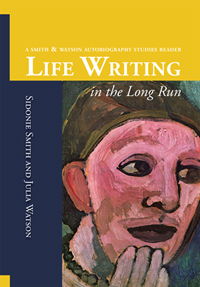
Life Writing in the Long Run: A Smith & Watson Autobiography Studies Reader
Skip other details (including permanent urls, DOI, citation information): Ann Arbor, MI: Michigan Publishing, University of Michigan Library, 2017.
: This work is licensed under a Creative Commons Attribution-NonCommercial-NoDerivatives 3.0 License. Please contact [email protected] to use this work in a way not covered by the license.
For more information, read Michigan Publishing's access and usage policy.
Table of Contents
- Dedication
- Life Writing in the Long Run for the Classroom: Coordinating the Essays with 20 Specific Topics
- Acknowledgments and Permissions
-
A Personal Introduction to Life Writing in the Long Run
- Part I: Theoretical Frameworks
-
1. Introduction: Situating Subjectivity in Women’s Autobiographical Practices (1998)
-
2. The Rumpled Bed of Autobiography: Extravagant Lives, Extravagant Questions (2001)
-
3. Witness or False Witness?: Metrics of Authenticity, Collective I-Formations, and the Ethic of Verification in First-Person Testimony (2012)
- Part II: Everyday Lives and Autobiographical Storytelling
-
4. Introduction to Getting a Life: The Everyday Uses of Autobiography (1996)
-
5. Ordering the Family: Genealogy as Autobiographical Pedigree (Watson 1996)
-
6. Virtually Me: A Toolbox about Online Self-Presentation (2014)
- Part III: Enabling Concepts
-
7. Performativity, Autobiographical Practice, Resistance (Smith 1995)
-
8. The Spaces of Autobiographical Narrative (Watson 2007)
- 9. The Autobiographical Manifesto: Identities, Temporalities, Politics (Smith 1991) Print and e-book only
- Part IV: Visualized Lives
-
10. Introduction: Mapping Women’s Self-Representation at Visual/Textual Interfaces
-
11. Autographic Disclosures and Genealogies of Desire in Alison Bechdel’s Fun Home (Watson 2008)
-
12. Re-Citing, Re-Siting, and Re-Sighting Likeness: Reading the Family Archive in Drucilla Modjeska’s Poppy and Sally Morgan’s My Place (Smith 1994)
-
13. Human Rights and Comics: Autobiographical Avatars, Crisis Witnessing, and Transnational Rescue Networks (Smith 2011)
- Part V: Women’s Life Writing in America
-
14. Introduction: Living in Public (2006)
- 15. Cheesecake, Nymphs, and “We the People”: Un/National Subjects about 1900 (Smith 1994) Print and e-book only
- 16. Strategic Autoethnography and American Ethnicity Debates: The Metrics of Authenticity in When I Was Puerto Rican (Watson 2013) Print and e-book only
-
17. “America’s Exhibit A”: Hillary Rodham Clinton’s Living History and the Genres of Authenticity (Smith 2012)
- Part VI: Global Circuits, Political Formations
-
18. Introduction: De/Colonization and the Politics of Discourse (1992)
-
19. Memory, Narrative, and the Discourses of Identity in Abeng and No Telephone to Heaven (Smith 1999)
-
20. Narratives and Rights: Zlata’s Diary and the Circulation of Stories of Suffering Ethnicity (Smith 2006)
-
21. Parsua Bashi’s Nylon Road: The Visual Dialogics of Witnessing in Iranian Women’s Graphic Memoir (Watson 2016)
- About the Authors


